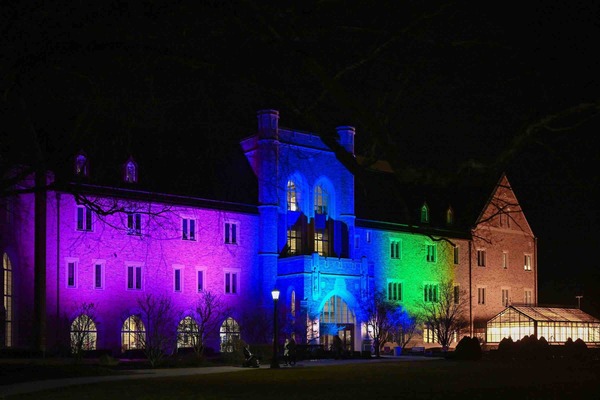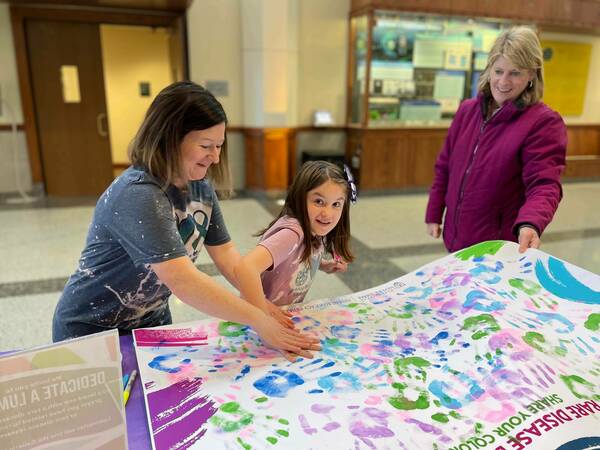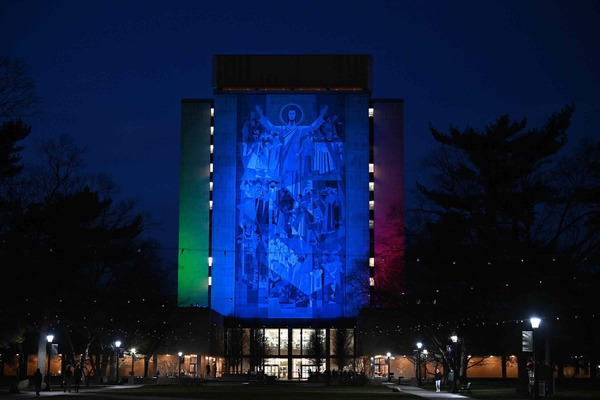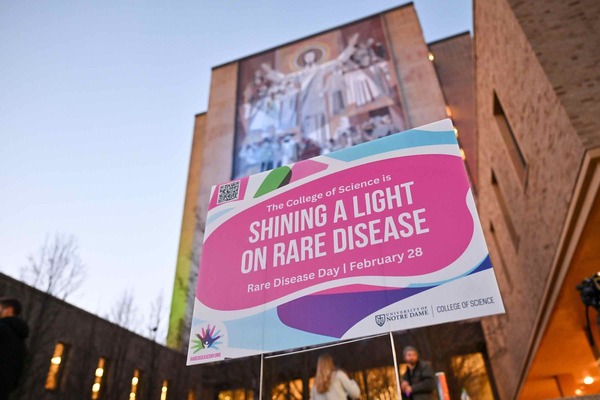
Third-grader Skylar Sevison eagerly squished her hand into a tin of purple fingerpaint in Jordan Hall of Science, then stamped it onto a poster with other colorful handprints representing Rare Disease Day 2023, encouraged by the patient-led’s movement for those with rare disease to “show their colors.”

Skylar, of Goshen, Indiana, was diagnosed at 14 months with neurofibromatosis Type 1 (NF) after her family searched for answers for 10 months stemming from an unusual leg break during her infancy. The University of Notre Dame observed the day on February 28 with the lighting of the Hesburgh Library and the Jordan Hall of Science, then capped off the week with the 14th Annual Conference on Advancing Rare Disease Research, Therapy, and Patient Advocacy conference on March 3-4.
NF causes benign or malignant tumors on the skin and along the nerves as people age. A small number of patients, like Skylar, also have pseudoarthrosis, which creates bowing and brittleness in the weight-bearing bones, particularly in the legs.
“A lot of people will ask me why one shoe is taller than the other, and I just say it’s because of my brace,” said Skylar, who has gone through three major and several minor surgeries to correct bone issues. “I tell them it’s my special leg.”

Rare diseases are those that affect only about 400 million people in the entire world, and about 200,000 in the United States. There are fewer than 10,000 rare diseases identified by Global Genes, but only a few people are affected by each of the different diseases. Often called “orphan” diseases because there is little support for them, they are challenging for patients, doctors, and researchers, said Barbara Calhoun, director of the advocacy, education, and outreach initiative for rare diseases in the College of Science.
“This does not mean that any patient should be left behind, or that rare diseases are less important than diseases affecting millions,” she said during the lighting ceremony using the pink, green, and blue colors representing Rare Disease Day. “These diseases are often chronic, progressive, and life-threatening, with no known cure—those living with these disorders face challenges that go beyond the physical ones they encounter daily.”
Nicole Sevison, Skylar’s mother, has spoken with classes focusing on rare diseases at Notre Dame ever since Skylar’s pediatrician connected her with Calhoun several years ago. Skylar receives most of her treatment at Shriners Hospital for Children in Chicago, though also visits a neurologist at Riley Children’s Hospital in Indianapolis. After Skylar was diagnosed and had a rod implanted into her leg, she had been progressing relatively well until she fell off a stool in December 2020. This second devastating fracture in her leg, just below the point where a rod ended above her ankle from a previous procedure, led to emergency surgery. It’s just one example of the roller coaster of dealing with a rare disease.
Sevison is a nurse, so she understands how to research diseases and find treatments—skills that have allowed her to navigate the medical world easier than many. Still, finding support is tricky. Though she did not attend the most recent conference, she has in the past, and found the support and connections she’s made through Notre Dame to be invaluable.
“I deal with this by speaking and sharing, but to be quite honest, because my family is non-medical, this program has brought them into the fold and actually made them more comfortable hearing or talking about Skylar’s disorder,” Sevison said. “Going to conferences and talking to other families has been so helpful, and I don’t know where they would have ever been exposed to it.”
At the most recent conference, researchers presented findings on a variety of different topics. Dr. Andrew Lieberman, a professor of pathology at the University of Michigan, described the latest research about Niemann Pick Type C, while Catherine Brownstein, assistant professor of pediatrics at Harvard Medical School and a research associate at Boston Children’s Hospital, described rare disease gene discovery. Dr. Gerard Vockey, a medical geneticist specializing in rare diseases at Children’s Hospital of Pittsburgh, described how using pathobiology could drive new treatments for rare diseases.

Additionally, Notre Dame researchers Zachary Schafer, the Coleman Foundation Associate Professor of Cancer Biology, Rebecca Wingert, the Elizabeth and Michael Gallagher Assocate Professor, and Jason Rohr, the Ludmilla F., Stephen J., and Robert T. Galla College Professor and Department Chair, all in the Department of Biological Sciences, gave talks in their respective fields and moderated panels, as did Sean Kassen, director of the Ara Parseghian Medical Research Fund at Notre Dame.
Overall, the goal of the conference was to provide a place for support and resources for rare disease patients, Calhoun said, and to discuss the importance of building collaborative relationships among researchers.
Though Skylar is scheduled for another surgery soon, it will have to be wedged between her many late-spring and early-summer activities: dance and swim classes, 4-H cake decorating class, and a trip to North Carolina. Jazz dance is her favorite, which helps bring her out of her shell. As she described, “I am shy, but once I start doing something fun, I’m not so shy anymore.”
This has helped her talk about her disorder in ways other children can understand.
“After people ask what’s wrong with you, and I just say I have a disability and we call this my special leg, then they start feeling as comfortable as I do when they (understand) what happened,” she said.
Notre Dame’s conference was organized by the College of Science, The Boler-Parseghian Center for Rare and Neglected Diseases, the Patient Advocacy Initiative, and the Ara Parseghian Medical Research Fund.
Rare Disease Day is on February 29 next year—the rarest day on the calendar.
Originally published by at science.nd.edu on March 10, 2023.